Armored car Minerva (Belgium)
It is curious that the army of the Kingdom of Belgium at the beginning of the First World War was distinguished by a relatively high degree of motorization. The development of the latest technology has led to the fact that already in 1912, patrol car units were formed. They used serial cars, armed with machine guns available models. Such equipment could move freely on the developed road network of Belgium and made a significant contribution to the country's defense. However, the lack of protection was a clear disadvantage of the available machines.
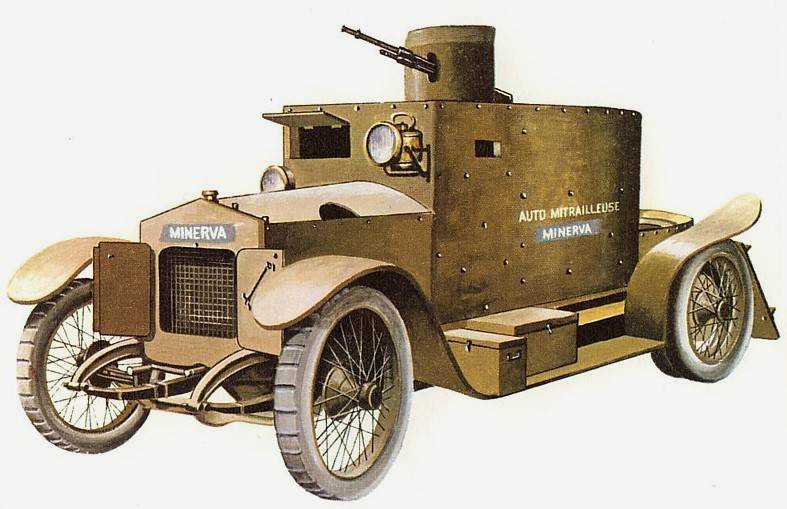
Reconstruction of the appearance of the Minerva armored car. Drawing Landships.info
In early August, 1914, just a few days after Belgium entered the war, Lieutenant Charles Ancar proposed to build new armored cars. Serial chassis technology, with protection and machine guns, could strengthen existing units and provide some advantages over the enemy. Initially, two armored cars should have been assembled, and in obtaining positive results it was possible to deploy full-scale mass production.
Wanting to help his country, Lieutenant Ankar "donated" two of his own car brand Minerva Motor Works. This fact affected the size of the first batch of equipment, which was to show the correctness of the proposal and the solutions used. A couple of civilian cars were transferred to the Cockerill Works plant in Hoboken. The employees of this enterprise, in cooperation with the military, were to carry out restructuring. In the case of the appearance of an order for the mass production of armored cars, it was planned to involve the Minerva company (the city of Antwerp), which was to assemble the required chassis.
Perspective armored cars were to be built on the chassis of the company Minerva Motor Works. This fact determined the future name of military equipment. According to the name of the company-manufacturer of base cars armored car called "Minerva". To avoid confusion, this name was often accompanied by the specification of the class of the machine. In this case, the technique was designated as Automitrailleuse Minerva - "Minerva Self-Propelled Machine Gun."
According to reports, Sh. Ankar proposed to build the first armored cars based on the chassis of the Minerva 16CV passenger car. From the existing chassis, it was necessary to remove the body and part of other units, instead of which it was planned to mount an armored body. Preliminary calculations showed that the new body will give additional load on the undercarriage. Last strengthened by installing additional wheels.
The 16CV type chassis was completed with a Minerva 8L carburetor gasoline engine with 40 horsepower. Through a mechanical transmission, which had in its composition a manual gearbox and propeller shaft, torque was given to the rear drive axle. Due to the lack of reasonable alternatives, as well as due to the presence of acceptable roads, the armored car could well have the wheel formula 4х2. The suspension was built on the basis of bridges and leaf springs. The front steering wheels remained flat. Rear axle equipped with double wheels, which was to compensate for the increase in mass.
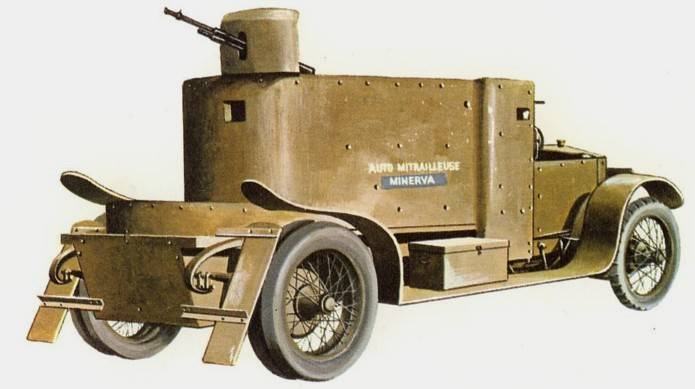
View of the stern. Drawing Landships.info
The original armored hull designed by Sh. Ankar and his colleagues should be installed on top of the chassis. The body consisted of sheets of various shapes and sizes that had a thickness of no more than 4 mm. Individual parts of the required configuration were fixed on the common frame. The corps was supposed to provide protection from rifle bullets. weapons and light fragments. For a variety of reasons, the hull did not receive a roof. The open case allowed to get into the car “over the side” and to do without side hatches weakening the structure. In addition, the project "Minerva" implied the use of a machine gun turret.
The armored body consisted of two main units. The front, which had a smaller size, served as the hood. He received a pentagonal frontal sheet with a large hatch for the supply of air to the radiator. In a combat situation, this hatch was closed by a pair of hinged doors. On the side, the engine was defended by a side mounted at an angle to the longitudinal axis of the chassis. From above, the power plant was covered with a relatively narrow longitudinal sheet, leaving small openings near the sides. This did not impair the protection of the engine, but facilitated the access of air. On a similar cover large headlights were placed to illuminate the road in the dark.
Inhabited compartment differed greater complexity of design. Its front part, which served as the separation of control, was made in the form of a rectangular box of sufficient size. A vertical front sheet was placed above the engine cover. On the sides of the crew were large vertical sides. The aft fighting compartment was characterized by a greater complexity of the contours. The rear housing unit was formed by a pair of rectangular vertical sheets, between which there was a large curved part.
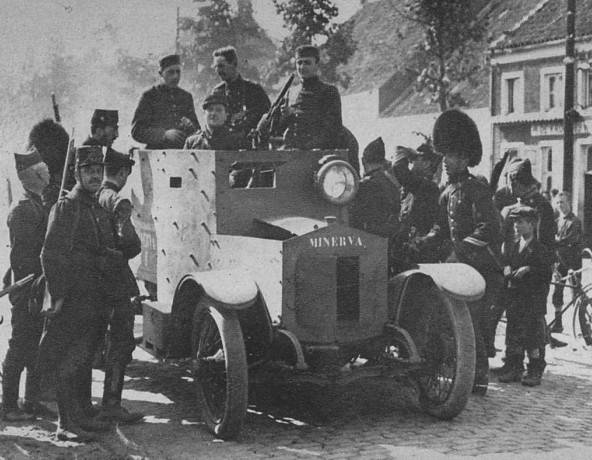
Armored car and its crew. Photo Landships.info
The fighting compartment ended to the rear axle, due to which the stern of the frame had to be equipped with its own protection. This unit covered the armor box of small height with a beveled rear sheet. The top sheet of such a casing had attachments for the transport of the spare wheel. On the sides of the feed box was a pair of rectangular plates covering the wheels.
The body of the Minerva armored car was supplemented with a set of external boxes for the transportation of property. Metal units placed outside the main body could, to a certain extent, increase the overall level of protection of certain sections of armor. Two drawers were fixed on the left side: the front had a smaller height with a greater width, whereas the back one was narrower, but taller. The right side was equipped with smaller boxes. All additional boxes for the property were fixed on the side of the hull and on the side footboard, made in the form of one piece with the wings of the wheels.
On the rounded feed assembly of the armored corps, above the conventional fighting compartment, there was an annular support of the machine-gun turret. It was proposed to place weapons on a mobile unit with the possibility of free pointing in two planes. The shooter could move the entire machine-gun installation in the right direction and implement a thin tip by moving the actual machine gun. The mobile support of the weapon was completed with an armored shield with a vertical embrasure.
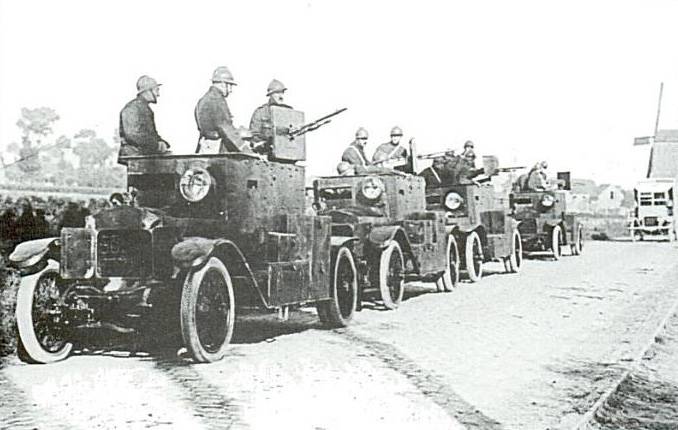
Column "Minerv" on the highway. Wikimedia Commons Photos
The Minerva’s only weapon of an armored car was the Hotchkiss Modèle 1909 machine gun, chambered for 7,92x57 mm “Mauser” (according to other sources, for ammunition such as 8x50 mm “Lebel”). This weapon used ammunition based on rigid metal tape cassettes and showed technical rate of fire at the level of 500 shots per minute.
The crew’s personal weapon could be used as an additional weapon for the armored car. The lack of a roof allowed crew members to fire across the board, complementing the "main caliber" in the form of a machine gun.
The crew was supposed to include from three to six people. The crew in all cases included the driver, commander and machine gunner. Also, the crew could be strengthened with three additional arrows with rifles. The crew had to get into the car through the open top of the hull. To monitor the situation, the driver had a front and side inspection hatches. A larger frontal was equipped with a hinged lid. There was another access hatch in the center of the stern. For obvious reasons, the machine gunner and additional arrows had to follow the terrain on top of the hull sides.
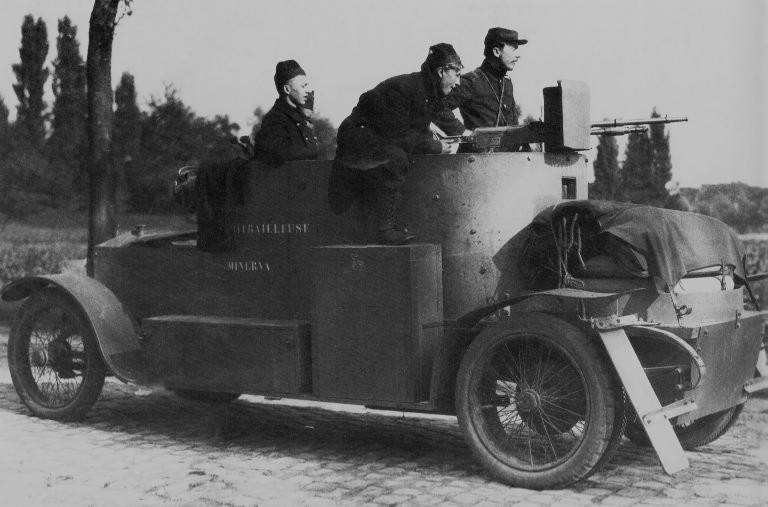
The lack of a roof gave certain amenities. Photo Landships.info
The Belgian Minerva armored car had a total length of about 4,9 m with a width of 1,75 m and an altitude of 2,3 m. The combat weight reached 4 tons. On the highway, the car could reach speeds up to 40 km / h. Power reserve - 150 km. On rough terrain, the ride quality of the existing chassis deteriorated, but the armored car could still be driven off-road, including overcoming obstacles.
The first two armored vehicles of the new type were rebuilt from the cars of Lieutenant Ankara in just a few weeks, no later than the end of August 1914. After the required checks, the new equipment was handed over to the army. The command became interested in this project, and soon an order appeared for mass production of equipment. The Minerva company was supposed to build an 16CV type chassis without any initial “automotive” equipment. They should be transferred to another company to equip with armor.
Production of Minerva armored cars continued for several weeks. In late September, German troops began the siege of Antwerp. In less than two weeks, the city came under German control, and Minerva Motor Works was no longer able to supply chassis for the construction of armored vehicles for the Belgian army. Before the loss of Antwerp, the company managed to assemble and deliver the required chassis order 30-35. All of them were completed under the existing project, but further production of armored cars was not possible. As a result, the total number of "Minerv" no longer increased.
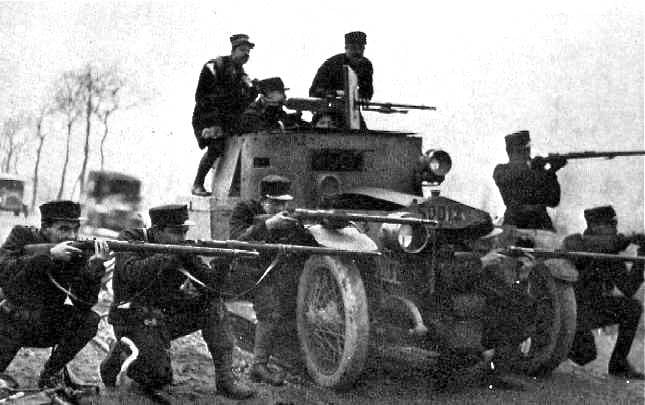
Belgian soldiers are ready to meet the enemy with dense rifle and machine-gun fire. Wikimedia Commons Photos
In early September, the first Belgian armored cars 1914 went to the front. This technique had the expected impact on the course of the fighting and gave the army certain advantages over the enemy. However, it was not without difficulties and problems. In addition, there were first losses. So, already September 6 one of the first Minerva armored vehicles was ambushed. The lack of a roof led to tragedy. The enemy fire killed Lieutenant S. Ankar. The remaining crew members were able to escape from the environment, save themselves and the car.
In the future, serial armored cars of the Automitrailleuse Minerva type were used for solving a number of tasks. The technique was reduced to several platoons, three cars each. These units were sent to support infantry and cavalry. In addition to the direct support of the troops, the crews were engaged in conducting reconnaissance in the near rear, patrolling specified areas, etc. In all cases, the armor showed, in general, good results.
Belgian armored cars for a long time participated in the battles over the occupied territories. A little later, they managed to take part in battles in another theater of military operations. In the spring of 1915, a significant number of Belgian soldiers and officers, led by Major Collon, became part of the Corps des Autos-Canons-Mitrailleuses Belges en Russie Expeditionary Force. In mid-autumn, this compound went to the Russian Empire. Together with the servicemen, a number of vehicles, including 12 armored vehicles, including the Minerva, were delivered to the new duty station.
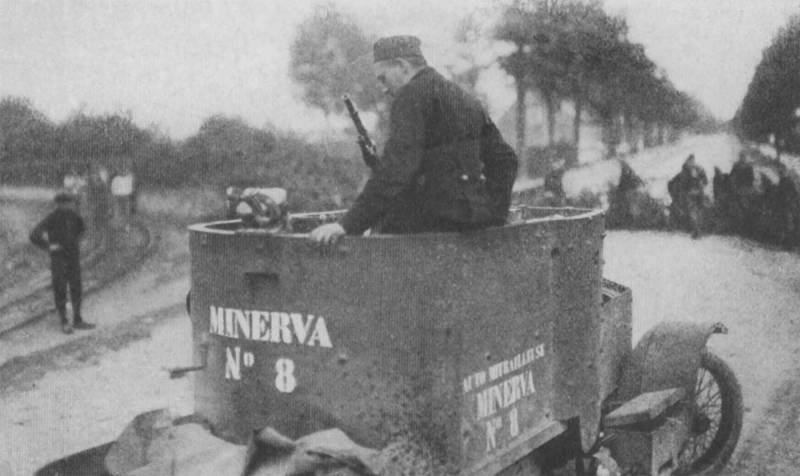
Armored car Minerva №8 and his machine gunner. Photo of Chicago Tribune, Feb 11, 1915 / Wikimedia Commons
Fighting on two fronts, the Belgian armored cars from time to time suffered losses. The available reservation allowed to protect people and equipment only from small arms bullets, but did not guarantee rescue at short distances. Artillery guns destroyed such equipment without any problems. It is curious that the Belgian Expeditionary Force lost only one Minerva-type vehicle. She was captured by German troops and was later put into operation. It is known that this particular armored car survived to the end of the war, and in 1919, it was used in the suppression of mass actions in Berlin.
One of the main reasons for the loss of people and machines "Minerva" was the lack of a roof of the hull. Bullets and fragments fell through the top and hit the crews. In 1916, work began on the modernization of the remaining armored vehicles in order to improve the safety of crews. All existing machines were to receive a roof thickness of 4 mm, completely covering the upper cut of the hull. Medium-sized doors appeared on the sides of the hull, providing access to the car. A hemispherical turret with devices for mounting a machine gun was now placed in the rear of the hull. In the shortest possible time, all the existing armored cars underwent a similar revision.
According to reports, almost all Minerva armored vehicles retained machinegun armament. At least one machine was equipped with a Puteaux SA 37 18-mm threaded gun. This led to a sharp increase in firepower and, consequently, combat effectiveness.
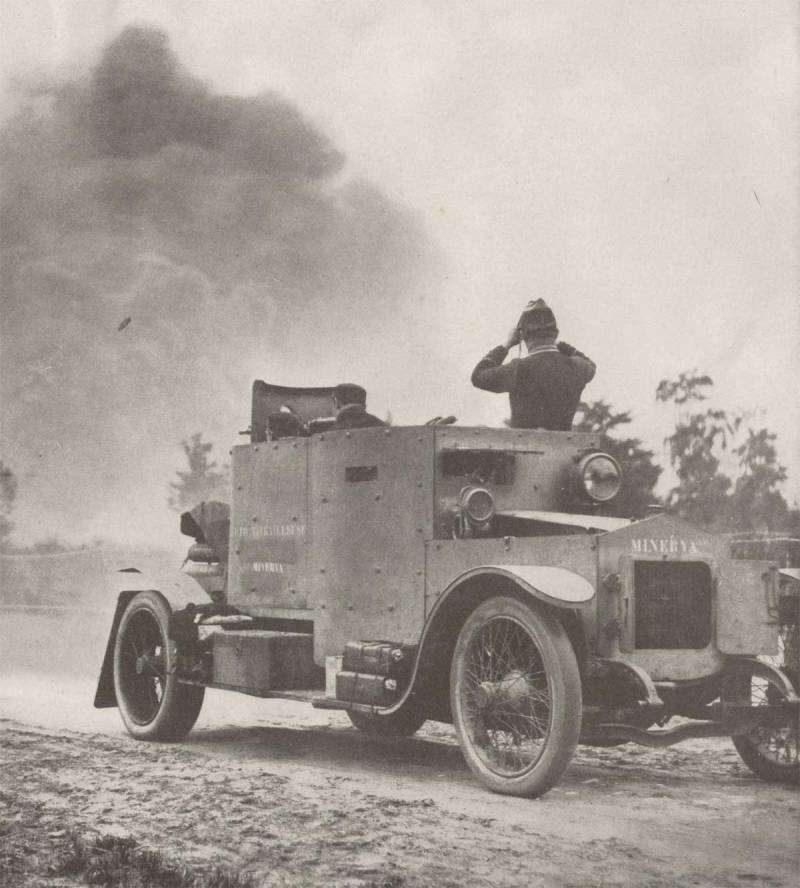
The commander is looking for targets, the shooter is attacking. Photo of the newspaper Tensas gazette, Feb 26, 1915 / Wikimedia Commons
Combat use of modernized armored vehicles continued until the very end of the First World War. By the time of the cessation of hostilities, a significant number of Minerva vehicles had been lost under certain circumstances, but the Belgian army still maintained a significant share of such equipment. The end of the war could raise the question of the further service of the existing armored vehicles, but it was quickly resolved in a positive way.
Despite limited characteristics, relatively large age and certain problems, the Minerva armored cars retained some of their potential. They decided to leave in service until the new models. The service of such machines in the army continued, according to various sources, until the mid-twenties. After that, the military wrote off the available equipment and handed it over to the gendarmerie. This structure showed great interest in armored vehicles and continued their operation. Only at the beginning of the thirties the equipment became outdated morally and physically, which launched the process of decommissioning and replacement. The latest Minerva vehicles were retired gendarmes only in 1935 year.
Needing armored combat vehicles, the Kingdom of Belgium at the very beginning of World War I created several new armored vehicles. Despite the lack of experience in this area, the first projects were, on the whole, successful. In addition, the Belgian automakers managed to establish a mass production of equipment, which, however, was soon discontinued due to the loss of the manufacturer. Despite this, the first Belgian armored cars of the Minerva type were quite numerous and left a noticeable mark on the military stories your country.
On the materials of the sites:
http://minervamotor-car.50megs.com/
https://militaryfactory.com/
http://tanks-encyclopedia.com/
http://aviarmor.net/
http://landships.info/
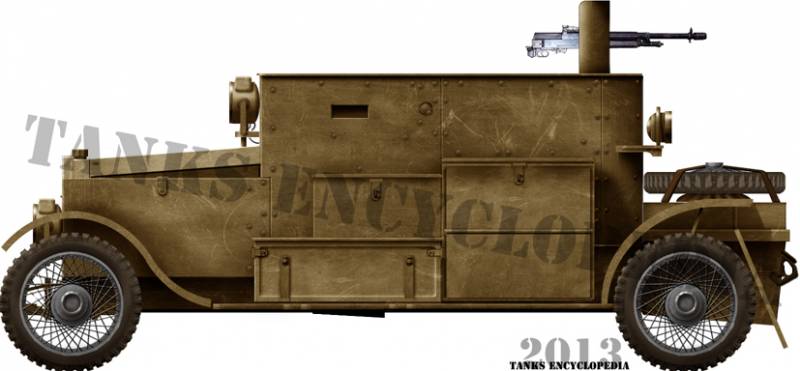
Information